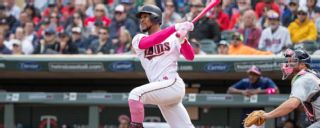|
We've waited nearly four calendar years for his arrival as a force in fantasy baseball, but judging by his early 2019 returns, it's time to declare it: Consider this your last chance to acquire Byron Buxton at an affordable price. If that seems unexpected, your impression is understandable. Buxton has now been a member of the Minnesota Twins' active roster for 379 career games, and has averaged .235/.290/.397 rates, 12.4 home runs, 47.9 RBIs, 23.1 stolen bases and 66.7 runs scored per 162. Even this season, he has been only a back-end mixed-league asset, the near-entirety of his value on the Player Rater coming from his eight stolen bases in an era of scarcity in the category. Look under the hood, though, and Buxton's performance to date has belied his basic rotisserie statistics. He's making significantly harder contact Buxton's 92.4 mph average exit velocity -- the speed at which the ball leaves his bat -- ranks 24th best among the 174 hitters who qualified for the batting title through Sunday, and dwarfs the 87.7 mph average he had during his parts of four previous big-league seasons. Only during his September 2016 outburst did he ever have even a 90 mph mark in any extended (minimum one month) period, registering 90.7 mph during that 29-game span. But it's more than that: Buxton is also generating hard contact at a far greater rate, striking the baseball at an exit velocity of 95 mph or faster on 46 percent of his batted balls this season, per Statcast, again dwarfing his 30 percent rate from 2015-18. Buxton's hitting has taken a definitive step forward in 2019. He's hitting the ball in the air more often Buxton's launch angle -- the degree at which the ball leaves his bat -- is 20.5 degrees this season, a sizable rise from the 12 degrees he averaged from 2015-18. His ground-ball rate has plummeted accordingly, as he has hit only 26 percent of his balls in play on the ground this season, after doing so on 42 percent of them in his first four big-league seasons. Greater elevation of the ball won't help Buxton's power numbers only (his one home run to date is unusually low considering his batted-ball profile in 2019); it'll also boost his other rotisserie numbers, like batting average, RBIs and runs scored, due to the greater likelihood of hits due to more line drives and his speed helping him leg out more extra-base hits when he hits the ball into the outfield gaps. He's no longer a liability against right-handed pitching A mere .231/.280/.394 hitter who made contact on only 65.4 percent of his at-bats from 2015-18, Buxton has boosted his performance against righties to .258/.314/.474 and a 75.3 percent contact rate. Perhaps more importantly, Buxton's contact quality hasn't been all that much worse against righties than lefties this season, as all 10 of his "hard outs" (outs on batted balls judged as hard contact) came against righties. This puts him at less risk of being platooned, not to mention casts less of a shadow on his batting average. He's got speed to burn Buxton's raw speed, meanwhile, is 80-grade, and there's no questioning that his performance in the stolen base category will remain on pace, if not improve, if his on-base percentage rises. Since his June 14, 2015, major league debut: Buxton's 88.5 percent success rate on stolen base attempts is the best in baseball (minimum 25 attempts), and he's the major league leader in Statcast's sprint speed with his 30.3 feet-per-second rate. In fact, Buxton has led that particular Statcast category in three of his first four big-league seasons, always with a rate faster than 30 feet per second. The only time he fell short of the top spot was when Victor Robles had a 30.9 mark on only 13 measured runs (Buxton, who was second, averaged 30.5 on 144 of his own that season). What are the negatives? This isn't to say that Buxton is without warts. He still misses often when he swings, his 15.0 percent swinging-strike rate 27th highest among the aforementioned group of batting title-eligibles. That caps his batting-average upside, and he does come with the injury question, having made four career trips to the injured list for a total of 104 lost team games since his 2015 debut. Buxton also consistently slots ninth in the Twins' lineup, which caps his number of plate appearances while limiting RBI chances. It'd be helpful if he goes on a tear in the power departments so he could move up a few spots, even if ultimately only to sixth or seventh. Rest-of-2019 forecast A true Buxton "breakout" might not be any greater than his current .276 batting average (and perhaps as many as 10-15 points worse), but with 15-homer power from this point forward. Pair that with what's a current 33-steal pace -- something that might indeed improve if he moves up in the order and grabs a few more PAs over the course of the season -- and he's a legitimate threat for a top-50 finish on the Player Rater. At the very least, Buxton should beat his 2017 final numbers, a line that earned him the No. 121 overall spot, and perhaps he could approach Trea Turner's -- a line that earned him the No. 33 overall spot -- in that same season. Chances are, you won't have to pay anywhere near the trade price of splitting the difference between those two stat lines. Happy shopping!
|

